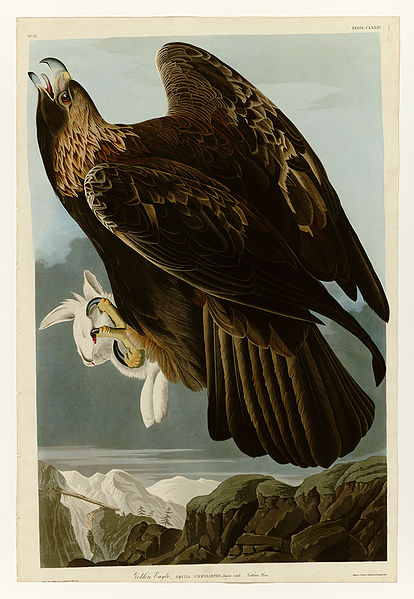John James Audubon (1785-1851)
Audubon was perhaps the best known illustrator of natural history in the nineteenth century. He was born in Santo Domingo (now Haiti), the illegitimate child of a French planter and sea captain and his Creole mistress. His father took him to France, where he remained until 1803. He then fled conscription in Napoleon’s army by moving to Pennsylvania. A series of failed businesses left him briefly jailed for bankruptcy in 1819. John Keats called him “dishonest” (September 1819) after Audubon lost money from the poet’s family inheritance on a failed riverboat scheme. Audubon’s hobby of bird illustration became a serious undertaking after he met Alexander Wilson, author of American Ornithology (1808-14). In the early 1820s Audubon traveled through the American south, collecting specimens and producing drawings. Throughout his life, Audubon spent countless hours in woods, fields, and swamps: finding, killing, and collecting specimens.
Most earlier bird artists had used only skins to create their illustrations. Audubon used some skins, and he occasionally painted from life, but his typical method was to hunt birds in the morning and then draw from their still warm bodies, before the colors had faded. He also wired dead birds into realistic postures that increased the veracity of his images.His depictions of birds hunting, feeding, defending their nests, and rearing their young contributed to a new sense of continuities between human and nonhuman life. His passionate and relentless pursuit of new species and new naturalistic settings for his drawings and paintings led to a new sense of the range and richness of American flora and fauna. His ability to combine his skills as a natural historian with the emotional energy of his art were one of America’s greatest examples of Romantic natural history. He was among the first to lament the loss of avian habitat and the wider impact of humans on the natural world. Within several decades of his death, a number of the species he had painted were gone forever: the passenger pigeon, the Carolina parakeet, and the Eskimo curlew among them.
Finding little commercial success in America, Audubon traveled to Edinburgh and London where, between 1826 and 1838 he supervised the production of 87 sets of 435 plates for The Birds of America. Most of the birds were portrayed life-size on 29-x-39 inch sheets of paper, producing the so-called “double elephant” folio. He also wrote–with William MacGillivray– Ornithological Biography (1831-39), a series of reflections about the characteristics and habits of the birds he drew, supplemented by reflections about his own travels. This work has a literary and historical value that has yet to be fully appreciated. Audubon corresponded with many naturalists of the day (Jean Louis Agassiz, Spencer F. Baird) and engaged in numerous discussions about particular species and the details of bird biology. He also collaborated with other artists and naturalists (George Lehman, John Bachman) on various aspects of his work. He returned to America in 1839, settling down along the Hudson River and working with his sons on Viviparous Quadrupeds of America (1845-48). While Audubon’s observational accuracy has been debated by ornithologists and naturalists, the artistic energy and the widespread public impact of his work have made him a major figure in the history of wildlife illustration. (A.N.)
Audubon links
The Birds of America (link to Nature.Net images from The Birds of America)
“Drawn from Nature: Audubon’s Artistic Legacy” by Laura Harbold (Dickinson, Class of ’07). Weblink from Humanities , March/April 2007, Volume 28:2


